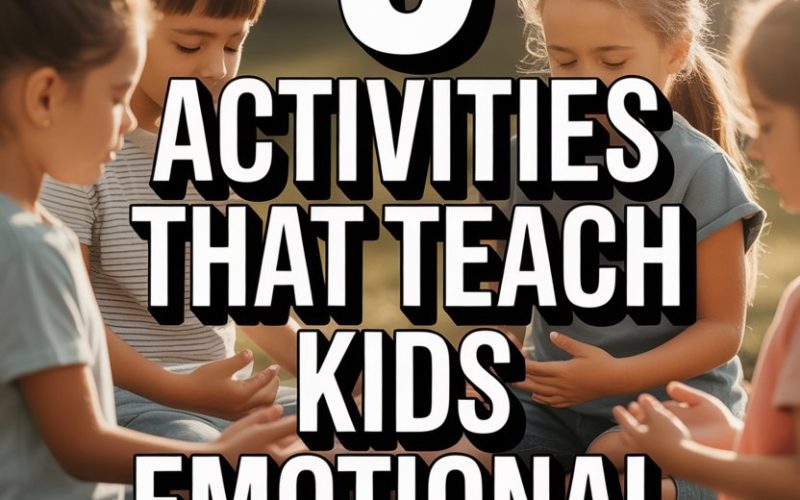There’s nothing quite like the full‑body drama of a child in meltdown mode to make you question your own emotional control.
As parents, we wish there was a magic wand that could give our little ones the ability to calmly discuss their feelings — or at least not hurl their sandwiches across the room when the crusts are left on.
While that particular spell hasn’t made it to the parenting market, there are some tried‑and‑true activities that can help kids harness their big feelings.
These activities require no degree in child psychology, no Pinterest‑level craftiness, and can be squeezed in between dinner, bath, and that never‑ending pile of laundry.
Ready for fewer tears… and maybe a little less yelling from all sides?
Here are five activities that actually help kids learn emotional control — and yes, you can try them tonight, even if the only craft supplies in your house are half a packet of dried‑up markers.
1. Breathing Buddies
Deep breathing is one of the oldest tricks in the emotional‑regulation book — and for good reason. It’s simple, it’s free, and even the most tightly wound toddler can learn it (eventually).
The challenge? Getting kids to actually do it, instead of hyperventilating theatrically.
Here’s where the Breathing Buddy comes in. Hand your child a soft toy, cushion, or even a rolled‑up pair of socks (we’re not judging) and have them lie down with it on their tummy.
The goal: breathe in slowly through the nose so the buddy rises, then out through the mouth, letting it fall. Suddenly, deep breathing isn’t just boring — it’s an excuse to make your stuffed elephant do yoga.
Psychologists recommend this practice for helping children develop awareness of their breath and body (see the Child Mind Institute), which calms the nervous system and gives their brains a moment to catch up with their emotions.
It works best when practised outside crisis hours, but even in the middle of a meltdown, offering a Breathing Buddy can sometimes break the spell.
Bonus: It works for grown‑ups, too. You just have to pretend you’re modelling excellent behaviour rather than taking a well‑deserved minute to yourself.
2. Feelings Charades
If your child is more likely to become a professional mime than an open‑book communicator, this one’s for you.
Emotional vocabulary is a huge part of emotional control — you can’t regulate what you can’t name. Yet many children (and quite a few adults, let’s be honest) struggle to put words to feelings that are spinning around like a rogue washing machine.
Set up a game of Feelings Charades. Write different emotions on slips of paper: happy, frustrated, worried, excited, embarrassed, jealous (yes, even the trickier ones). Take turns acting them out while everyone else guesses the emotion.
Encourage your child to use their whole body, face, and voice, not just wild hand gestures. After each round, ask: “When have you felt this way?” or “What happened next?”
According to child‑development experts — see the Gottman Institute’s work on Emotion Coaching — helping kids recognise and label feelings can reduce emotional outbursts and improve problem‑solving skills.
And if your own performance of “mildly irritated” deserves an Oscar? Treat yourself to a biscuit. You’ve earned it.
3. Glitter Jars
Don’t panic — this is the only activity that involves anything remotely mess‑adjacent, and it’s worth it. A glitter jar (sometimes called a “calm‑down jar”) is a simple tool to give kids a visual way to watch their big feelings settle.
Grab an empty plastic bottle or clear jar, fill it with water, add glitter glue or loose glitter, and give it a good shake. The swirling glitter represents the chaos of strong emotions.
As your child watches it slowly settle, you can narrate: “When we’re upset, our thoughts are all jumbled, like the glitter. When we’re calm, everything gets clearer.”
This isn’t just a cute craft. Mindfulness activities like this have been shown in research to boost emotional regulation in children.
Plus, few things are as hypnotic as watching sparkles float lazily to the bottom, which might buy you thirty seconds of blessed silence.
Feeling extra inspired? Let your child customise their jar with food colouring, sequins, or even tiny plastic toys. That way, they’re more likely to reach for it voluntarily when tempers start to flare.
4. The Calm‑Down Spot
Time‑outs have earned a bad reputation in recent years, but a calm‑down spot is a different beast altogether. This is not a place for punishment. Instead, it’s a safe, cosy nook meant for emotional reset — no shame, no lectures.
Just a soft cushion, a couple of books, maybe a favourite stuffed friend (the less judgmental, the better).
Encourage your child to visit the calm‑down spot when they feel overwhelmed. Stock it with sensory items: squishy balls, a soft blanket, noise‑cancelling headphones, or a picture book about feelings (try The Color Monster for the under‑sevens).
Let your child know this is their space to regroup, not a time‑out from life.
Experts in child psychology, including those at Zero to Three, recommend calm‑down corners because they give kids agency over their own emotions — a vital skill for self‑regulation.
Over time, children learn that it’s okay to step away and cool off, rather than exploding all over the living room.
And for the record: adults are allowed to have a calm‑down spot too. Even if it’s just the bathroom with the door locked.
5. Storytelling With a Twist
Sweeping tales have always been humanity’s way to make sense of life’s chaos. Storytelling is a secret weapon for emotional control: it lets children process feelings and rehearse different ways to solve problems, all under the comforting gaze of a parent.
Here’s how to add a twist. As you read a picture book or make up a story, pause whenever a character faces a problem. Ask your child: “What do you think they’re feeling right now? What could they do next?”
This conversation links emotions with actions, encouraging your child to consider the consequences of different choices.
If your child loves to take the reins, let them invent a story about a character grappling with a tough emotion. Maybe it’s a dragon who gets nervous before flying class, or a puppy who’s jealous of a new sibling.
The point isn’t to craft a literary masterpiece — it’s to practise empathy, perspective‑taking, and the all‑important art of not letting feelings run the show.
Research backs this up: a study in Journal of Early Intervention found that storytelling involving emotional discussion improves both emotional understanding and self‑control in young children.
And if your child’s tale involves a unicorn who solves everything with cake? That’s just good storytelling.
Emotional Self‑Regulation Is a Gift — and a Skill
Emotional control doesn’t arrive with the tooth fairy or grow from eating broccoli (pity). It’s a skill, built through small, consistent practices that help kids recognise, name, and manage their feelings.
Try one or two of these activities this week. You may be surprised by how quickly your child picks up new ways to cope — and by how much calmer your home feels as a result.
Even if nothing goes to plan, there’s always comfort in knowing you’re doing the messy, wonderful work of raising a human who can handle life’s wild ride, one deep breath (or glitter jar shake) at a time.





